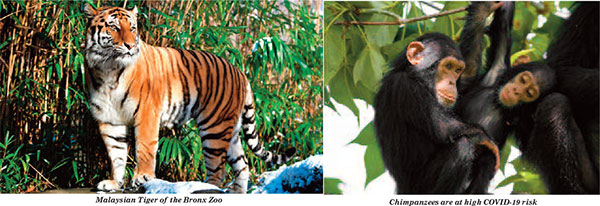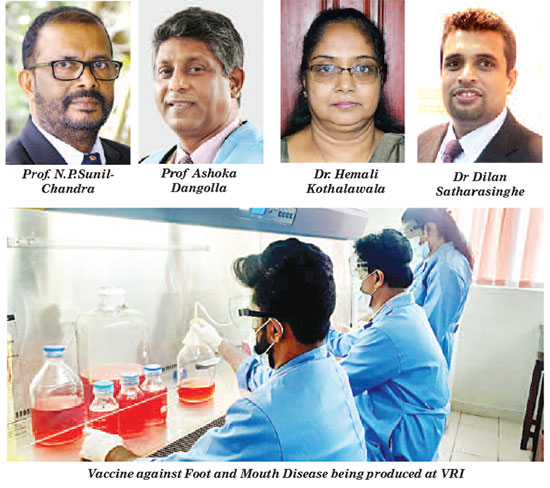Life style
Paws and hands in harmony

With incidents of animals being tested positive for COVID-19 both locally and in various parts of the world, there is a discourse and public anxiety about potential animal to human and human to animal transmission of the virus. We spoke to several authorities committed to animal welfare and virology to find answers and to dispel unnecessary fears.
by Randima Attygalle
The 14-year-old African Lion, ‘Thor’ of the Dehiwala Zoo, gifted by a zoo in Seoul, was reported to be having severe respiratory signs including breathing difficulties and a nasal discharge. Its loss of appetite and lethargy further worried keepers. On an official request made by the Director (Animal Health and Nutrition), Department of National Zoological Gardens, Department of Medical Microbiology of the Faculty of Medicine, University of Kelaniya tested the nasal swab specimens of the sick lion for COVID-19. Fecal samples of the infected animal were sent to the Molecular and Nutritional Biochemistry Laboratory (MNBL) at the Faculty of Veterinary Medicine and Animal Science, University of Peradeniya. Both laboratories confirmed the lion to be COVID-19 positive. This is the first known case of an animal contracting COVID-19 here at home.
The lion was confirmed COVID-19 positive according to the criteria of the World Organization for Animal Health (OIE), Prof. N.P Sunil-Chandra, Virologist and Chair of Medical Microbiology from the Faulty of Medicine, University of Kelaniya told the Sunday Island. “The nature of a specimen, whether it is human, animal or of environmental origin, is not going to alter the result. Hence COVID-19 PCR procedure adopted for the respiratory samples of the infected lion was the same as that which is used for human samples,” he said.
While veterinarians and other staff of the Dehiwala Zoo have been tested, further investigations, assisted by zoo authorities, are being carried out to identify the exact source of infection in the lion. Asymptomatic human infection is a very likely source for the infection in the lion, he said.
“Asymptomatic human infection was incriminated as the source infection in the case of a COVID infected four-year-old Malaysian tiger in the Bronx Zoo, USA which was reported in March last year. Infected pet cats have also been reported in Belgium, Hong Kong, USA and Brazil but there is not enough evidence to change the current opinion of the OIE that neither cats nor dogs appear to be able to pass the virus to people,” the senior professor said.
 SARS CoV-2 infections in minks in the Netherlands and in Denmark have been reported in close proximity to a region with high incidence of COVID-19 in humans. A mutation of the SARS CoV-2 virus in a mink in Denmark and one of the variant was found in several people, he explained.
SARS CoV-2 infections in minks in the Netherlands and in Denmark have been reported in close proximity to a region with high incidence of COVID-19 in humans. A mutation of the SARS CoV-2 virus in a mink in Denmark and one of the variant was found in several people, he explained.
In 1918 the world experienced its worst flu outbreak (commonly called the Spanish flu) due to an influenza virus type A strain H1N1 which emerged in birds infected a third of the world’s human population killing over 50 million people. Three more influenza pandemics followed: in 1957 ‘Asian’ flu (A-H2N2), in 1968 ‘Hong Kong’ flu (A-H3N2) and the 2009 ‘swine’ flu (A-H1N1). “Although milder than the 1918 pandemic, these highlight the constant threat of es to human health.
Emergence of SARS CoV-2 virus in 2019 which led to the current COVID-19 global pandemic further highlights the threat of emerging zoonotic virus infections,” observed Prof Sunil-Chandra. He elaborated on the importance of working on ‘One Health’ concept (the collaborative efforts of multiple disciplines working locally, nationally and globally, to attain optimal health for people, animals and the environment) when confronted with emerging zoonotic infections such as COVID-19.
“Climate changes and deforestation affect animal reservoirs of viruses and due these adverse effects animal migration leads to increased interactions in the animal-human interface. This could spread viruses to new locations and across a wider range of domestic and wildlife species including birds and bats.”
‘Spillover events’ from wildlife via vectors or domestic animals are the starting points for many outbreaks, from influenza to HIV and from SARS to COVID-19, pointed out the Virologist. “Therefore, it is natural to have misconceptions among people with pandemic stress about how new diseases jump from animals to human. Although it is theoretically possible that the virus can be transmitted from an infected animal to human, todate there is no evidence for SARS CoV-2 transmission from animals to humans. Mink is the only animal known to have passed the coronavirus to humans, except for the initial spillover event from an unknown species in China.”
According to the OIE, there is no evidence that cats or dogs spread the disease to humans bit it recommends that sick persons with COVID-19 should avoid contact with pets, including petting, cuddling, being kissed or licked, and sharing food, in order to protect their pets during the time of their illness.
Gorillas and chimpanzees are identified as animals that are at very high COVID-19 risk, pointed out Prof. Ashoka Dangolla, Senior Lecturer in Veterinary Clinical Studies from the Faculty of Veterinary Medicine and Animal Science, (FVMAS) University of Peradeniya. Felines such as domestic cats, tigers and lions are at a medium risk he said. “Veterinarians are very familiar with other animal Coronavirus infections in cats. This has been so for several decades. Feline infectious peritonitis is one such condition with respiratory signs in cats. But we must keep in mind that COVID-19 is a novel Coronavirus (SARS CoV-2) which has the ability to mutate into new variants. Therefore, all possible precautions must be taken while extending love and compassion to our pets.”
Since it is known that cat family members can contract the disease from symptomatic and asymptomatic parties, it is advisable to keep away from them if you are COVID-19 positive or suspected of it, Prof. Dangolla advises. “Cats cannot, according to available information, infect humans. But if you do find your cat having respiratory symptoms, it’s always advisable to take the cat to a vet in the area.”
Care should also be taken not to feed monkeys and to dispose of our waste in an irresponsible manner, the senior veterinarian warns. Dogs are of low risk for developing COVID-19. “So far, COVID- 19 positive dogs have not been reported in Sri Lanka though we test all dogs that are being brought into the country for COVID-19. If a household dog shows respiratory signs such as difficulty in breathing, best advice is to show it to a vet.”
Susceptibility of dogs, pigs and elephants to COVID-19 is low whilst ferrets, mink, mice and rats have very low susceptibility, says the veterinarian. Birds have never been reported to be COVID positive. COVID positive Asian elephants have been documented in India, therefore it is advisable not to go near captive elephants if a person is COVID positive or asymptomatic he notes. “If an infected (symptomatic or asymptomatic) person gets close to a healthy elephant, closer than two meters, the elephant may get infected, but there is no report to say that elephants infect people. Sheep, cattle and even dolphins can get infected but they are at medium risk.”
Since our local vets have been working with Coronavirus and the Sri Lanka Veterinary Research Institute has been producing several vaccines against viruses in animals, we can have some hope that the vets would produce a vaccine against COVID in animals if a need arises, says Prof Dangolla.
The Molecular and Nutritional Biochemistry laboratory of FVMAS, University of Peradeniya conducts tests to detect COVID-19 and the presence of SARS-like viruses in animals. Since September, 2020, the lab had been offering services to the Department of Animal Production and Health (DAPH) to screen hundreds of animals for COVID-19 infection that came into the country. These came as pets through the Animal Quarantine Department at the Bandaranaike International Airport (BIA) which operates under DAPH said Dr. Dilan Satharasinghe, Senior Lecturer from the Department of Basic Veterinary Sciences, FVMAS, University of Peradeniya.
“We have also screened mangroves and toque monkeys as a part of a surveillance programme implemented via DAPH in collaboration with the Wildlife Department and it is an ongoing process,” he said. DAPH and Animal Quarantine Division at the BIA screen all animals coming into the country for COVID-19 infection. Samples are referred to the Molecular and Nutritional Biochemistry laboratory and upon the confirmation of negative results, animals are released to the owners.
The Department of Animal Production and Health (DAPH) implements disease control programmes mainly through Directorates of Animal Health and Veterinary Research. The DAPH has strong structure throughout the country with 26 Regional Veterinary Investigating Centres (RVICs), one located in each district. The disease control programmes are implemented by its islandwide network of 337 Government Veterinary Offices (GVOs) which come under nine Provincial Departments of Animal Production and Health (PDAPH). The central Veterinary Investigating Centres and the technical divisions of Veterinary Research Institute (VRI) provide referral diagnostic facilities for Regional VICs and GVOs in managing diseases.
Curative and Preventive measures are carried out by the DAPH and PDAPH. Disease investigations, epidemiological studies, surveillance programmes and vaccination programmes are being carried out in managing viral diseases.
Animal Disease Act No.59 of 1992 stipulates that no person can import any animal or animal related product without the permission of the Director General of Animal Production and Health. “This provision is to prevent the entry of any exotic disease to the country. Accordingly, animals, animal products, veterinary products and biological imports are controlled by the DAPH by issuing pre- clearance approval for such imports,” said the Director General of Animal Production and Health, Dr. Hemali Kothalawala.
Quarantine stations are established in ports of entry such as Katunayake, Colombo, Mattala and Jaffna to control imports through air and sea passage. Animal entry is permitted based on negative test certificates of certain given diseases and in high-risk situations animals are being quarantined for a number of days at the quarantine stations or on-farm, explained Dr. Kothalawala. “Apart from these routine protocols, today a COVID-negative certificate is mandatory when importing any animal to the country.”
The Animal Disease Act also requires the Director General of Animal Production and Health to take action to control animal disease spread in the country. Today DAPH has established a diagnostic facility with animal specific RT-PCR antigen kits and an Epidemiological Survey is planned to uncover the factors associated with the COVID-19.
The Veterinary Research Institute (VRI), of DAPH has a long history of vaccine production in Sri Lanka. VRI produces several viral vaccines and bacterial vaccines for the livestock sector in the country. Among the viral vaccines, the most important as Dr. Kothalawala explained, is the one for Foot and Mouth Disease (FMD) which causes severe milk production drop in cows when infected. The vaccine which was first produced locally in 1964 is now developed using the latest technology to enhance the immune duration and its shelf life. “Presently, 50% of the country’s requirement is produced within the country. Recently approved project on FMD control is planning to expand the capacity by two-fold by end of the next year,” Dr. Kothalawala said.
A viral vaccine for goat Contagious Pustular Dermatitis (CPD) which causes severe production loss and kid mortality is also being produced at the VRI. It also produces a live viral vaccine for New Castle Disease which causes a very high death rate among chicken. While a newly invented vaccine with oil adjutant to give lifelong immunity in birds is ready to release for the industry another vaccine is being produced by VRI as well as Veterinary Investigation Centres for warts in cattle, she noted. Several bacterial vaccines are also being produced at the VRI for deadly diseases in cattle and poultry. A vaccine for tick fever which causes severe economic losses in milk production especially in high producing animals such as cattle and buffalo is also being produced at the VRI.
Life style
Elevating Sri Lanka’s standing in global luxury events

Anantara Peace Haven Tangalle Bungalow
 The grand opening of Peace Haven Bungalow at Anantara Peace Haven Tangalle was celebrated with an unforgettable evening of opera. Guests were serenaded by internationally renowned talents including Concert Pianist Jean-Marc Pont Marchesi from Paris, Soprano Chrisni Mendis from Rome and Sri Lanka, and Russian Tenor Sergei Radchenko. These acclaimed artists were joined by celebrated local performers Indika Upamali and Subuddhi Lakmali, supported by Sanithi Dias, Manoj Sanjeewa, Madhava Bandara, Tusith Simpson, and Anosh Ismail. Anantara Peace Haven Tangalle Resort, part of Minor Hotels,recently the resort’s most exclusive and luxurious event venue to date. It was a grand evening of glitz,glamour and entertainment.
The grand opening of Peace Haven Bungalow at Anantara Peace Haven Tangalle was celebrated with an unforgettable evening of opera. Guests were serenaded by internationally renowned talents including Concert Pianist Jean-Marc Pont Marchesi from Paris, Soprano Chrisni Mendis from Rome and Sri Lanka, and Russian Tenor Sergei Radchenko. These acclaimed artists were joined by celebrated local performers Indika Upamali and Subuddhi Lakmali, supported by Sanithi Dias, Manoj Sanjeewa, Madhava Bandara, Tusith Simpson, and Anosh Ismail. Anantara Peace Haven Tangalle Resort, part of Minor Hotels,recently the resort’s most exclusive and luxurious event venue to date. It was a grand evening of glitz,glamour and entertainment.
Nestled along Sri Lanka’s breathtaking southern coastline, Peace Haven Bungalow offers a stunning canvas for elegant weddings, private occasions, and high-end MICE events, blending timeless elegance with signature Anantara hospitality.
Perched on a cliff with panoramic views of the Indian Ocean, this bungalow offers a unique setting for up to 200 guests. As the only venue of its kind along Sri Lanka’s southern coast, it answers the growing demand for world-class luxury event spaces in the region with bespoke event planning and immersive culinary experiences.
Following the magnificent performance, guests enjoyed a lavish dinner and wine pairing experience, all set against the stunning backdrop of the Indian Ocean.
“This evening marks the beginning of an extraordinary journey for Peace Haven Bungalow,” said Erik Billgren, General Manager of Anantara Peace Haven Tangalle Resort. “This venue is not just a space; it’s a catalyst for change in how we envision luxury celebrations, stories, and moments. Our signature Anantara hospitality is geared to uniquely cater to each guest from this stunning vantage point on Sri Lanka’s southern coast.”
The creation of Peace Haven Bungalow represents a shared vision with Hemas Holdings PLC, a partnership that harmoniously combines heritage, innovation, and a deep appreciation for Sri Lanka’s natural beauty. Offering panoramic ocean views, impeccable design, and tailored service, the venue is poised to set a new benchmark for premier events in Sri Lanka and beyond.
Anantara Peace Haven Tangalle Resort is set within a 22-acre coconut plantation, The resort is the only property in Tangalle situated on a rocky outcrop, offering a secluded and scenic retreat along Sri Lanka’s rugged southern coastline. The resort features 152 rooms and villas, including 14 Garden Pool Villas, 10 Ocean View Pool Villas, six Beach Pool Villas, and two -bedroom garden pool villas.
- Arrival of Ranil Wickremesinghe and Maithree Wickramasinghe
- Barbara Segal and Hemant Dadlani
- General Manager of Anantara Peace Haven Tangalle Resort – Erik Billgren addresses the gathering
- (L to R) Tasneem Moosajee, Shyamalee Tudawe, Kishore Reddy, Champika De Silva and two other guests of the event
- Dinner followed by the Opera event
- The team who performed at the Opera event
- Event setup
Life style
Glamour and elegance Illuminate Songkran Celebration

Cinnamon Lakeside , the epitome of luxury and refined hospitality hosted a spectacular two-day dining experience at its acclaimed Royal Thai Restaurant to commemorate Songkran, the cherished Thai New Year Festival,recently
This exclusive event was graced by the esteemed presence of ambassadors, high-profile media representatives, dignitaries, and distinguished guests who gathered to immerse themselves in a sumptuous celebration of Thai culture and cuisine. Kamal Munasinghe, Area Vice President, warmly welcomed attendees, setting a tone of elegance and cultural reverence.
The evenings unfolded in a spectacular tapestry of flavours and traditions, masterfully curated by the culinary team of The Royal Thai Restaurant. Guests were delighted by an exquisite menu, reflecting authentic Thai culinary artistry, presented with flawless sophistication and meticulous attention to detail.
The vibrant ambiance was accentuated by opulent décor reflecting the essence of Songkran. Guests were enchanted by captivating traditional Thai performances and authentic rituals that beautifully symbolized the renewal and prosperity at the heart of Songkran.
Cinnamon Lakeside Colombo continues to be celebrated as a beacon of glamour and hospitality, curating unforgettable experiences that blend rich cultural traditions with modern elegance.
Pix by Darmasena Welipitiya
Life style
“Walk to Equality”

“Walk to Equality” – A Fashion Show Celebrating Life Without Labels was held recently, media representatives and distinguished guests gathered at Cinnamon Grand Colombo for the official press conference of the Walk to Equality fashion show It was an inspiring initiative presented by The Walk Model Academy in partnership with Cinnamon Grand Colombo. With the powerful tagline “Life Without Labels,” this event aims to redefine fashion by championing inclusivity, diversity, and empowerment.
Set to take place on May 19th, the Walk to Equality fashion show will feature a groundbreaking lineup of models, highlighting their confidence and individuality on the runway. This bold move challenges conventional beauty standards while providing a platform for often underrepresented voices in the fashion world.
The press conference offered a heartfelt look into the mission behind the show and the stories of the individuals involved. Organizers emphasized the transformative nature of the initiative—not just as a show, but as a movement. With a strong focus on social impact, the event seeks to promote empathy, equality, and acceptance through the universal language of fashion.
Collaborating closely with the Equality team and a host of creative partners, the show has become a beacon of what’s possible when communities unite for a common cause. The behind-the-scenes journey, from training to fittings, has been designed to uplift and empower each model, making the event more than just a moment on the runway—it’s a celebration of strength and self-expression.
Tickets for the Walk to Equality fashion show are now available for purchase online, with proceeds going toward the Meals on Wheels charitable cause, supporting rural children in need. Those interested in attending, contributing, or simply spreading awareness are encouraged to visit our social media channels for updates, ticket information, or to become a well-wisher for this important initiative.
The Academy extended thier deepest gratitude to all who have helped bring this vision to life. They shared a special thank you to Cinnamon Grand Colombo, title and hospitality partner, for their continued belief in the power of inclusion. They extended thier thanks for all their generous sponsors for thier support and help
Together, we walk toward a world where every life is valued, and every person is seen—a life without labels sums up thier motto
-

 Opinion6 days ago
Opinion6 days agoRemembering Dr. Samuel Mathew: A Heart that Healed Countless Lives
-

 Business4 days ago
Business4 days agoAitken Spence Travels continues its leadership as the only Travelife-Certified DMC in Sri Lanka
-

 Latest News3 days ago
Latest News3 days agoNPP win Maharagama Urban Council
-

 Business4 days ago
Business4 days agoLinearSix and InsureMO® expand partnership
-

 Business2 days ago
Business2 days agoJohn Keells Properties and MullenLowe unveil “Minutes Away”
-

 Features6 days ago
Features6 days agoTrump’s economic missiles are boomeranging
-

 Latest News6 days ago
Latest News6 days agoThe Heat index is likely to increase up to ‘Caution level’ at some places in Eastern, Northern, North-central and North-western provinces and in Monaragala and Hambantota districts.
-

 Business3 days ago
Business3 days agoNDB Bank partners with Bishop’s College to launch NDB Pixel awareness



























